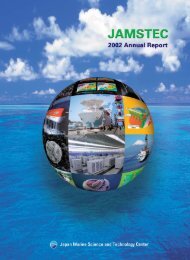2007 Annual Report - jamstec japan agency for marine-earth ...
2007 Annual Report - jamstec japan agency for marine-earth ...
2007 Annual Report - jamstec japan agency for marine-earth ...
Create successful ePaper yourself
Turn your PDF publications into a flip-book with our unique Google optimized e-Paper software.
Chapter 2. Results of FY<strong>2007</strong> Activities<br />
I. Measures to be taken to achieve the objectives <strong>for</strong><br />
improving the quality of services and other operations<br />
provided to the public<br />
1 Fundamental research and development concerning<br />
ocean science and technology<br />
1.1 Promotion of key research activities<br />
1.1.1 Observational Research <strong>for</strong> Global Change<br />
(1) Climate Variations Observational Research<br />
Program<br />
The objective of the Climate Variations Observational<br />
Research Program is to develop an extensive and continuous<br />
ocean observing system in the Pacific and Indian Ocean, to<br />
reveal the mechanisms of the variations in the upper layer with<br />
annual to decadal time scales. The Tropical Ocean Climate<br />
Group focuses mainly on the phenomena that occur in the warm<br />
water pool of the western Pacific and the eastern Indian Ocean<br />
while the Argo Group focuses mainly on interannual to decadal<br />
variations in the north Pacific. In order to further facilitate<br />
these research activities, under the cooperation with various<br />
international organizations, we will continue to develop the<br />
TRITON buoy mooring network in the equatorial Pacific and<br />
the Indian Ocean as well as developing the Argo float array<br />
with a focus on the mid-latitude regions of the both oceans.<br />
Tropical Ocean Climate Group<br />
Tropical Ocean Climate Group continued the observations<br />
in the western tropical Pacific and the eastern tropical Indian<br />
Ocean by using the TRITON buoy array and sub-surface ADCP<br />
moorings. Two cruises in the western tropical Pacific and one<br />
cruise in the east tropical Indian Ocean were conducted by R/V<br />
MIRAI under the cooperation with the Marine Technology<br />
Center of JAMSTEC. During these three cruises, total of 15<br />
TRITON buoys in the western tropical Pacific were<br />
recovered/deployed and 2 TRITON buoys in the east Indian<br />
Ocean were recovered. Also starting this year, 2 m-TRITON<br />
buoys funded directly by the Ministry of Education, Culture,<br />
Sports, Science and Technology (MEXT) were deployed<br />
replacing the TRITON buoys. The mooring location of the<br />
TRITON/m-TRITON buoys and sub-surface ADCP buoys were<br />
shown in Fig. 1.<br />
XCTD/XBT observations in the northern Indian Ocean<br />
were conducted by using the volunteer observation ships. The<br />
data obtained by this observation is delivered to the meteorological<br />
institutions in the world by GTS and is open to the public<br />
after the quality control. Some of the major results of analyzing<br />
these data obtained are introduced below.<br />
a. Zonal gradient of sea surface temperature and variation of<br />
Pacific warm pool associated with cooling in the western<br />
Pacific be<strong>for</strong>e the onset of El Niño.<br />
In order to clarify a role of interaction between the atmosphere<br />
and the ocean over the warm pool in the western tropical<br />
Pacific in the mechanism of onset of El Niño, upper ocean temperature<br />
variation around warm pool region west from 156 o E<br />
(hereafter, FWEP)where the TRITONN buoys were deployed<br />
was investigated from boreal winter of 2001 to boreal spring of<br />
2002 be<strong>for</strong>e the onset of the 2002/03 El Niño.<br />
Satellite data indicates that negative sea surface temperature<br />
anomalies are developed in the east coast of New Guinea be<strong>for</strong>e<br />
the onset of the 2002/03 El Niño (December, 2001) to expand<br />
eastward in a wide area of the western equatorial Pacific (Fig.<br />
2). At this time the sea surface temperature in FWEP showed a<br />
positive zonal gradient with enhancement of westerly wind<br />
anomalies to start moving the Pacific warm pool eastward, followed<br />
by the onset of the 2002/03 El Niño.<br />
Fig. 1 Mooring location of the buoys as of January, 2008. Red and blue solid circles indicate the buoys by JAMSTEC and the empty white circle<br />
indicates the Atlas buoys by NOAA of USA.<br />
17
















